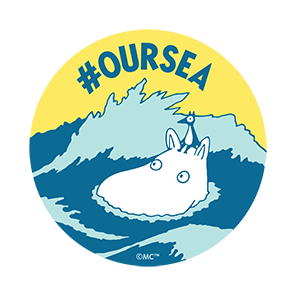#OURSEA, the joint campaign of Moomin Characters and the John Nurminen Foundation, informs people of the Baltic Sea and of different ways to help the sea. At the same time, we raise funds for the John Nurminen Foundation's work to save the Baltic Sea and its heritage. This blog will take you to the Baltic Sea, awakened by spring, and let you admire its marvellous creatures.
“An attraction for the sea must be a Moominous quality. I see with satisfaction that my son has inherited it. But, dear reader, please note that it is, rather, the beach that awakens our rapture. Far out on the sea a normal Moomin feels the horizon to be just a little too wide. We prefer what is varying and capricious in a friendly way, what is unexpected and peculiar: the beach, which is partly ground and partly water; the sunset, which is partly dusk and partly light; and spring, which is partly cold and partly warm.”
The Memoirs of Moominpappa
Early in spring, when the Sea is still covered by ice, microscopic algae start growing on the ice surface beneath the water, and also in pockets of salty water and pores inside the ice.
When sunlight reaches the water through thinning ice, the spring bloom of phytoplankton begins. As the ice departs, spring blooms gain strength and the water turns greenish with growths of microscopic planktonic algae. Microalgae are the basis of the sea’s food chain: the provide nutrition to tiny planktonic fauna, such as copepods, water fleas, and fish fry.
With increasing light and decreasing ice, many perennial algae (such as e.g. bladderwrack) and aquatic plants wake up after winter and start growing anew. The Arctic spring migration sweeps over the shores of the Baltic Sea as waterfowl stop by on their way up north to feed and regain their strength in the marine bays of the coastline. Gastropods, too, feed in the lush vegetation of the bays.
In spring, once ice is gone and the waters get warmer, it is spawning time for many fish species. Bream, roach and pike enter the sheltered bays to spawn there. Baltic herring, on the other hand, lay their spawn in the algae-protected bladderwrack zone.
Learn more about Baltic Sea fauna
Bladderwrack
Perennial bladderwrack growths are the lungs of the Baltic Sea. As they photosynthesize, they bring oxygen to the sea, and maintain a diverse biocenosis in a way similar to the coral reefs of the oceans. Bladderwrack clings to rocks and stones, providing a safe environment for fish fry to grow; it is also home to a host of marine invertebrates, from isopods to shrimp.

Great pond snail
The great pond snail feeds in verdant marine bays, eating aquatic plants, though it will not say no even to cadavers found on the seabed. It is the largest water snail in the Baltic Sea, and can grow up to 5 cm in size. The great pond snail is a pulmonate, which means that it goes to the surface for oxygen every now and then. Snails attach their eggs in a string of jelly on aquatic plants and rocks.

Let’s save #OURSEA together
We hope you will join us in securing the future of the Baltic Sea. By combining our forces, we can still save #OURSEA.
Take part in the campaign by making a donation at www.oursea.fi, or by disseminating information on the Baltic Sea and its status.


